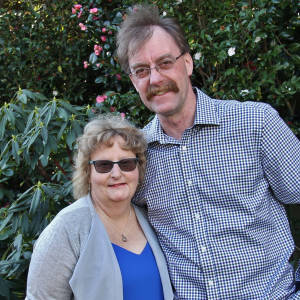Moody Nikau Palms and Cabbage Trees
We woke to low misty cloud hugging the steep forested mountains after a night of heavy rain. The Tasman Sea was crashing and pounding on the rocks but out on the horizon there was sun and blue sky. Hubby and I took a stroll through the small settlement of Granity, long known as a coal mining town but with a declining population as the industry has waned, some nearby towns have now become ghost towns. The name Granity was given to the town by gold prospectors, for the large quantity of granite found in the area.
We found a bandstand which had been restored by this small community, painted white with green trimmings and a large scale chess board painted on the floor. A church built in 1903 is now the local library, a primary school and museum along with a couple of arty crafty shops and a few cafes, all set on the main road with surrounding small cottages. A quiet sense of atmosphere with a 'she'll be right kind of attitude', the people always warm and friendly.
By early afternoon the rain was bucketing down in a real West Coast style, driving was differcult as we headed out to take the above image of cattle grazing beneath the Nikau Palms and Cabbage Trees, both endemic trees to New Zealand. It was windy and treacherous as I trudged along the side of the road, in the long grass and forever wiping my camera, the cattle are barely visable from the mist.
We decided to head up into the clouds to see the small settlement of Denniston, on the Mount Rochfort Plateau in the Papahaua Ranges, 600 metres above sea level. It was shrouded in cloud and gave us a real insight as to the conditions the workers and families would've had to put up with back in the early years of the 20th Century, I imagine on a good day the view would've been spectacular but this wouldn't have been on their minds. Denniston was a coal mining town with a population of close on 2000 all those years ago but today it is now a ghost town, telling a story all of its own. It was one of the country's most differcult mining towns to live in. Early access to the town was either up a steep pack track or in a coal wagon up the incline, where empty coal wagons were hauled up the hill at a 45 degree angle by the weight of loaded wagons descending down the slope. Well worth a visit if your in the area.
Late afternoon we headed to Westport, a coastal township located on the banks of the Buller River. It is the coast's oldest town and is the Northern Gateway to the West Coast, making its name in gold and coal mining. We went to Cape Foulwind, where the cheeky Weka's greeted us on our arrival. The Weka is a large flightless brown rail with a strong dagger-like bill. Plumage largely red brown with dark streaks, bill and legs orange-brown. While at Cape Foulwind we saw the seal colony of NZ Fur Seals and I took many shots of the lighthouse against a dramatic sky.
We packed alot in for our Day Four of our holiday, finishing off with a lovely meal at Granity's Drifters Cafe.
A link for some shots of the
Cheeky Weka

Comments
Sign in or get an account to comment.


